Can You Grow Bee Balm In Containers? A Guide for Small Spaces
So, you’ve got those high-rise vibes or maybe just a petite patio, but you’re itching to join the bee balm bonanza.
The big question on your mind: can you squeeze the glory of bee balm into a container and still expect it to thrive?
Short answer: Heck, yes! But there’s a bit more to the story.
Join me on this container-centric journey as we explore the ins, outs, dos, and don’ts of giving bee balm its very own potted palace.
Whether you’re a balcony gardener or just looking to jazz up the deck, I’ve got the tips to get your container game buzzing.
Bee Balm Planting Basics
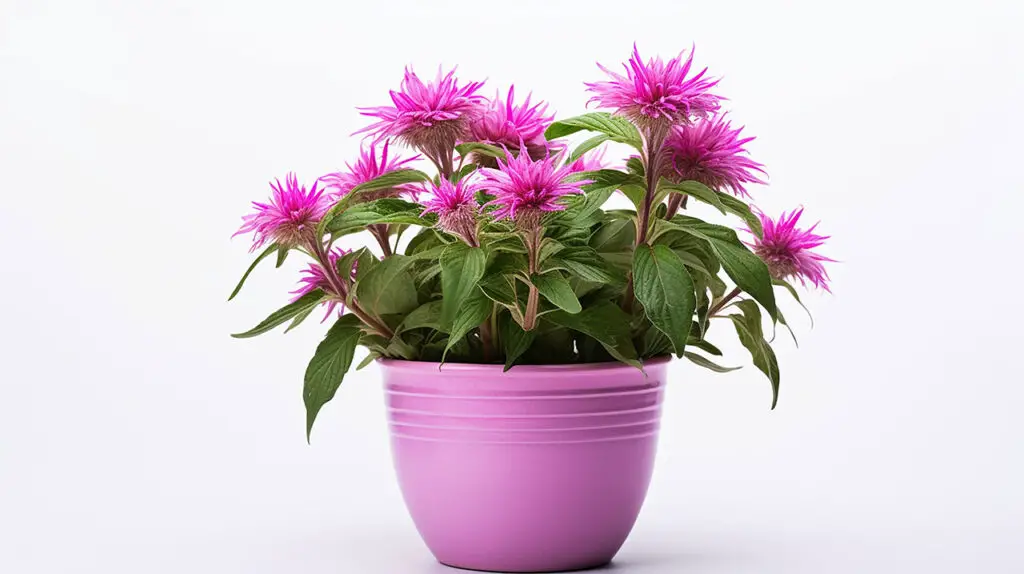
Choosing the Container
When growing bee balm in containers, it’s essential to choose a container with adequate size and drainage.
Bee balm plants can grow quite large, so opt for a pot that is at least 12-14 inches in diameter and has drainage holes to prevent water-logging.
Soil and pH Requirements
Bee balm thrives in well-draining soil which is rich in organic matter.
You may use a high-quality potting mix, and add compost to enhance soil fertility.
Bee balm prefers a neutral to slightly acidic pH, between 6.0 and 7.0.
You can test your soil’s pH using a soil testing kit and adjust accordingly with lime or sulfur, if necessary.
When and How to Plant
The ideal time to plant bee balm seeds is in early spring, once the threat of frost has passed.
Start by sowing seeds indoors, 6-8 weeks prior to transplanting outdoors.
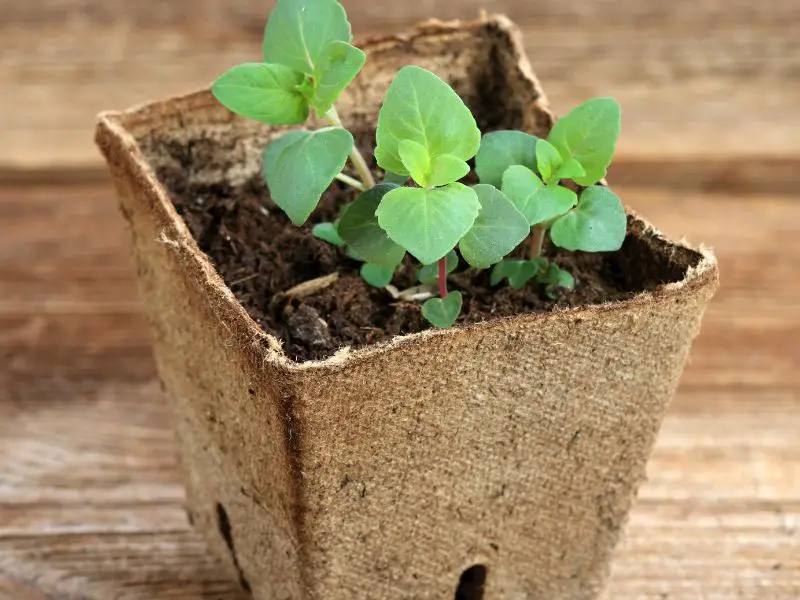
To plant, follow these steps:
- Fill your chosen container with prepared soil, leaving about an inch of space from the top.
- Scatter the seeds evenly over the soil surface, and lightly press them in.
- Cover the seeds with a 1/4-inch layer of soil or fine compost.
- Water the container thoroughly, ensuring the soil is evenly moist but not soggy.
- Place the container in a sunny spot, making sure it receives at least 6 hours of full sun each day.
As the bee balm plants grow, they will produce beautiful flower clusters in colors like red, pink, purple, or white.
Keep a close eye on the moisture levels and maintain consistent watering throughout the growing season.
Bee balms are also known to attract pollinators to your garden, making them an excellent choice for container gardeners looking to support local wildlife.
With proper care and a conducive environment, your bee balm plants should flourish and provide a stunning display of color in your container garden.
Care for Container-Grown Bee Balm
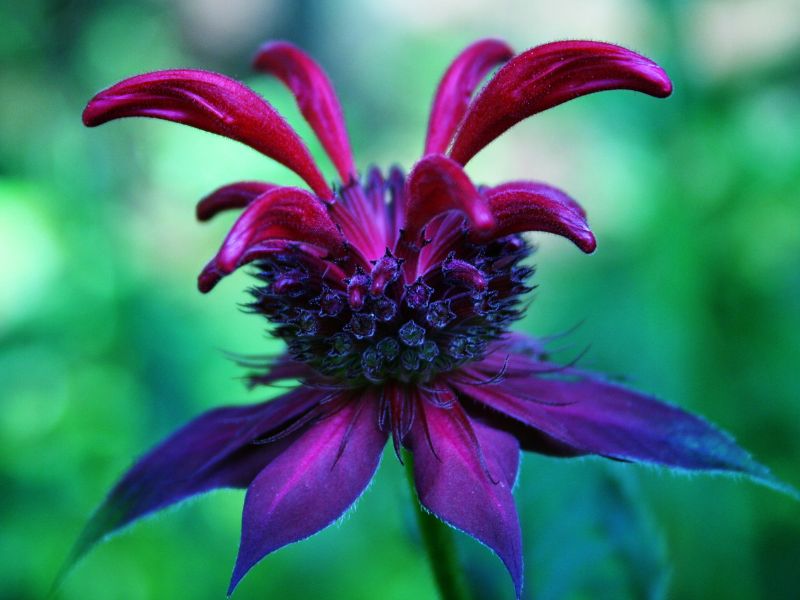
Watering Needs
For your container-grown bee balm to thrive, it’s essential to maintain even moisture levels.
Water the plant whenever the top inch of the soil feels dry.
A well-draining potting mix can help prevent overwatering, ensuring that your bee balm receives the right amount of moisture.
Fertilization and Feeding
Feeding your bee balm is vital for its growth.
Use a high-quality potting mix mixed with compost when planting the bee balm in the container.
Throughout the growing season, apply a balanced liquid fertilizer every 4-6 weeks to encourage healthy growth and blooming.
Mulching in Containers
Proper mulching provides several benefits for container-grown bee balm, such as regulating the soil temperature and retaining moisture.
To achieve this, spread a layer of organic mulch, like shredded leaves or bark, around the base of the plant.
This will help maintain a consistently moist and well-drained soil environment, promoting the overall health of your bee balm.
Propagation and Division
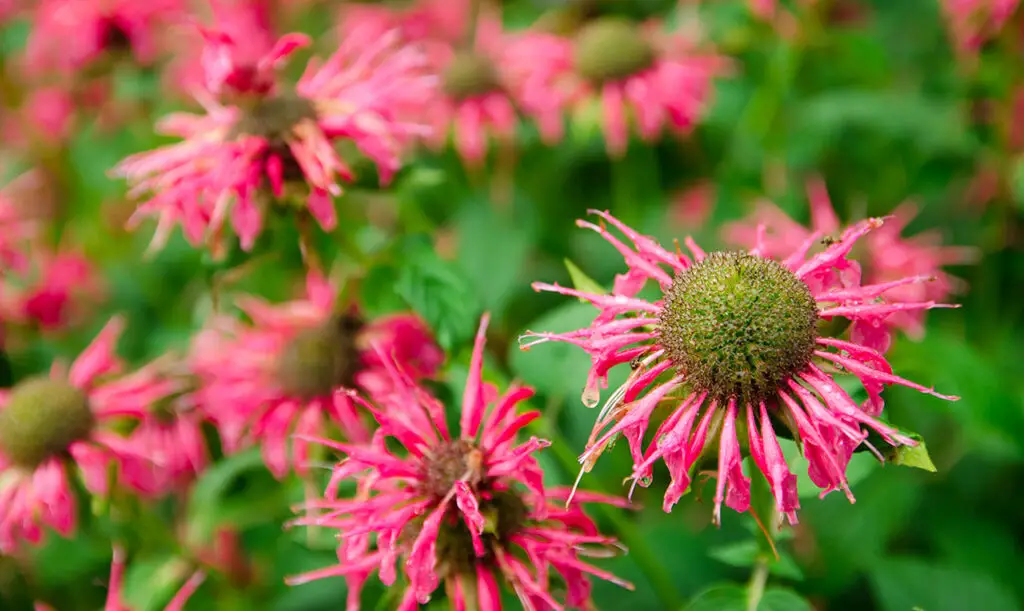
Propagation by Seeds
To propagate bee balm by seeds, you can start by sowing the seeds indoors in a container filled with a well-draining potting mix.
Keep the soil evenly moist and place the container in a sunny location.
The germination process usually takes 10-14 days.
Once the seedlings have a few sets of true leaves, you can transplant them into individual containers or directly outside in your garden after the last frost.
Remember to gradually acclimate the seedlings to outdoor conditions before transplanting them.
Propagation by Cuttings
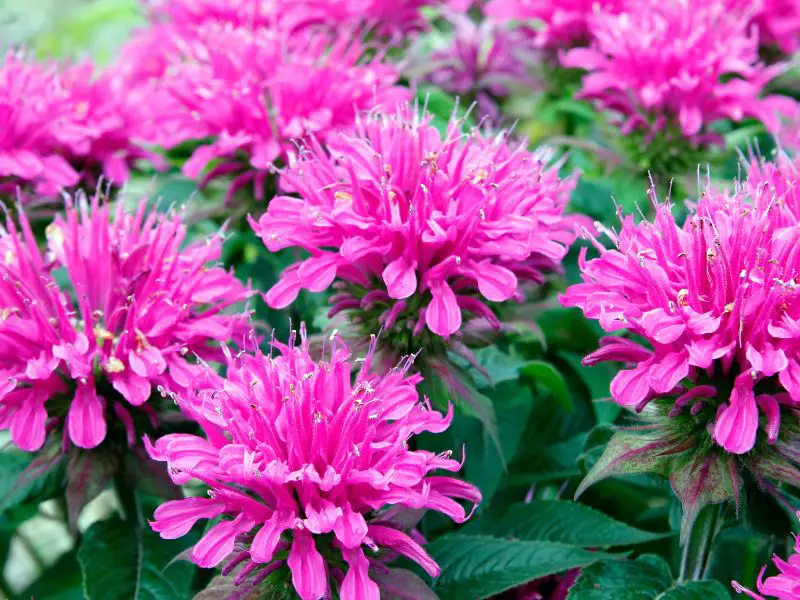
Another way to propagate bee balm is by taking stem cuttings.
Choose a healthy, well-grown plant and cut a 4-6 inch stem segment just below a leaf node.
Remove the lower leaves and dip the cut end in rooting hormone.
Then, plant the cutting in a container filled with a well-draining potting mix.
Keep the soil moist and place the container in a bright, indirect light location.
The cuttings should root within 3-4 weeks, and they can be transplanted outdoors or into a larger container once roots are well-established.
Division Method
The division method is the easiest way to propagate bee balm.
To do this, carefully dig up a mature plant, being cautious of the root system.
Divide the plant’s crown and root ball into sections, ensuring each new division has a healthy portion of roots and shoots.
Replant these divisions into appropriately-sized containers or directly into the garden, maintaining the same depth as the original plant.
Keep the soil moist and provide proper care as the divisions establish themselves in their new locations.
This method is best done in spring or fall, giving the plants ample time to recover and grow before the onset of extreme weather conditions.
Potential Pests and Problems
Growing bee balm in containers can come with a few potential issues that require attention.
In this section, we will discuss some common problems such as powdery mildew, rust, and pests like spider mites, and provide solutions to manage these issues.

Dealing with Powdery Mildew
Powdery mildew is a common fungal issue that affects Bee Balm plants.
It appears as a white or gray powdery coating on the leaves.
To prevent and manage powdery mildew:
- Ensure proper air circulation around your Bee Balm plants by spacing them apart and regularly pruning to remove dead leaves or stems.
- Water the plants at the base rather than overhead to avoid creating a damp environment that encourages mildew growth.
- If mildew is already present, consider using a fungicide specifically formulated to treat powdery mildew.
Managing Rust
Rust is another fungal issue that can occur on Bee Balm plants, characterized by orange or brown pustules on the undersides of leaves.
To manage rust:
- Remove and dispose of any infected leaves to prevent the spread of the fungus.
- Improve air circulation around your plants, as rust thrives in damp and stagnant conditions.
- Use a fungicide approved for rust management if necessary.
Pest Control
Pests like spider mites and aphids can be problematic for Bee Balm plants grown in containers.
To keep them under control:
- Regularly inspect your plants for signs of pests, such as small webs, discolored leaves, or the presence of tiny insects.
- Rinse your plants with a strong spray of water to dislodge pests and remove any webs.
- If pests persist, consider using a natural or chemical pesticide labeled for use on Bee Balm plants. Follow the product’s instructions for proper application and dosage.
Deadheading and Pruning
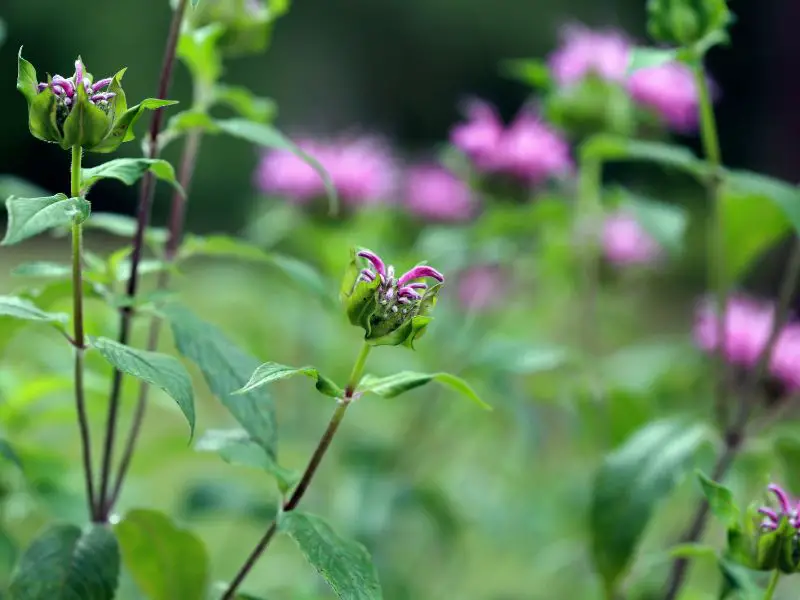
When to Deadhead
Deadheading is an essential part of maintaining the health and growth of your bee balm plants in containers.
This process helps in promoting healthy growth and triggering new blooms.
To know when to deadhead your bee balm, wait for your bee balm flowers to wilt or fade and the petals start to fall off.
This is the ideal time to begin deadheading, as it prompts the plant to produce more flowers.
Pruning Bee Balm
Pruning your container-grown bee balm is necessary to keep it looking tidy and encourage the production of more blooms.
Bee balm plants, which can reach up to 4 feet tall, need proper pruning to ensure they remain healthy and produce an abundant display of flowers.
- Start by cleaning and disinfecting your pruning shears to minimize the spread of funguses, pests, or diseases.
- For deadheading, cut back the flowering stem to within 1/4 inch of a leaf or leaf bud near the top of the stem.
- When pruning bee balm, remove any damaged, dead, or diseased stems to avoid spreading infections to other plants. Also, cut back any overly tall stems, as well as any that are rubbing against each other or growing inward.
- After pruning, make sure to clean up the garden area by raking up and composting or disposing of the removed flowers and stems.
Overwintering Container-Grown Bee Balm
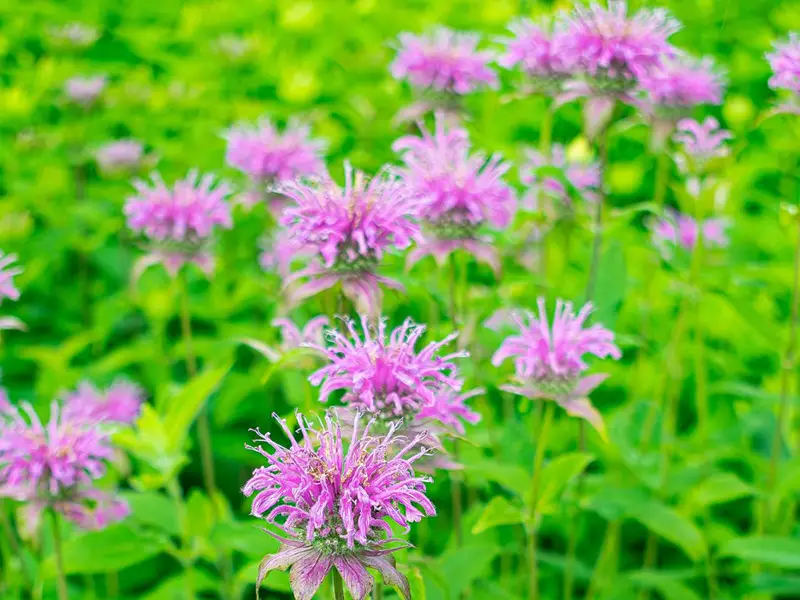
Preparing for Frost
As winter approaches and temperatures begin to drop, it’s essential to prepare your container-grown bee balm for the colder months ahead.
In fall, when frost is imminent, start by cutting back your bee balm plants to about 6 inches above the soil level.
This will help protect the plants from winter damage and promote healthy growth in the spring.
Next, add a layer of mulch, such as straw or shredded leaves, around the base of the plants.
This will provide insulation against frost and help maintain consistent soil moisture during winter months.
About 2-4 inches of mulch should be sufficient for this purpose.
Remember to keep an eye on the weather and be ready to take further steps if a sudden frost or unusually cold temperatures are expected.
Moving Containers Indoors
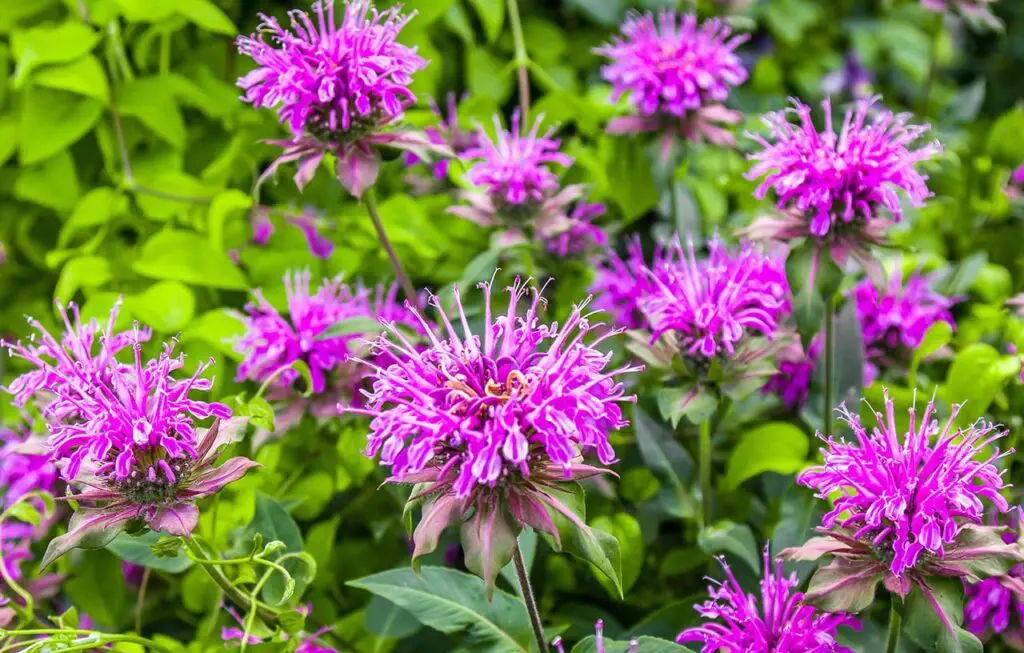
If you live in a region with harsh winters, it may be necessary to bring your container-grown bee balm plants indoors for additional protection.
When nighttime temperatures start to consistently dip below freezing, it’s time to consider moving your containers inside.
Select a cool, well-ventilated area in your home, such as a garage, basement, or enclosed porch, where temperatures stay between 40 and 50 degrees Fahrenheit.
Avoid placing the containers near heat sources, as this may cause the plants to dry out or encourage new growth, which would not fare well when the plants are transitioned back outside.
Once your bee balm plants are safely indoors, water them sparingly – just enough to keep the soil from completely drying out.
Overwatering during this dormant period could lead to root rot or other issues.
As spring arrives and temperatures begin to rise, gradually acclimate your bee balm plants to outdoor conditions before transplanting them back into their containers.
By easing them into their outdoor environment, you’ll help ensure a healthy and successful growing season for your container-grown bee balm.

